Trading Volatility Through Elevating Global Trade Turmoil
It looked as if it was going to be a dreadful day on Wall Street in the early morning on Thursday with the major averages pointing to a steep decline at the market’s open. Within the first hour of trading, however, all 3 major averages bottomed and made a sharp U-turn heading higher through the remainder of the trading day. At one point during yesterday’s trade, the Dow Jones Industrial Average was down nearly 200 points before turning around. The blue chip index finished off just 7 points while the S&P 500 finished higher by roughly 14 points and the Nasdaq outperformed its peers, finishing higher by 95 points. Tech stocks and Apple’s significant achievement led the markets rebound.
Apple shares rose 2.9% to $207.39 a share, lifting its market cap above the $1 trillion mark. Apple's stock has been on a tear since the company reported stronger-than-forecast quarterly results on Tuesday. Since then, the stock is up nearly 9 percent.
"It's good for confidence in the market to the extent that it's a widely owned stock," said Marc Chaikin, CEO of Chaikin Analytics. "A lot of market-cap weighted ETFs are getting a boost from this."
What made Thursday's rally on Wall Street rather amazing is that it came on the heels of elevated fear surrounding the increasing of global trade tensions. President Trump asked trade officials to raise the proposed tariffs on China from 10% to 25% on some $200bn in goods. This sent Asian and European stocks tumbling lower. The Shanghai Composite and Nikkei 225 dropped 2% and 1.03%, respectively. In Europe, the Stoxx 600 index fell 0.8 percent.
To round out the trading week, investors will turn their attention to the July Nonfarm Payroll report. July's employment report is expected to show strong job growth of 190,000, but wage growth is expected to remain on the soft and at roughly the same pace as the previous quarter The unemployment rate is expected to improve to 3.9% from 4% with average hourly wages expected to grow by 0.3%, or 2.7 percent on a year-over-year basis, according to Thomson Reuters. In June, 213,000 Nonfarm payrolls were created, and average wages grew by 0.2% or 2.7% year over year. The July report is released at 8:30 a.m. ET.
Economists have been watching for wages to pickup to a 3% or better pace, a sign of increasing inflation and more inline with historically low employment rates. The markets are most closely watching this particular wage data, since a more rapid rate of wage growth could signal the Fed that it needs to stay on its interest rate hiking path or even speed it up. Wage growth spooked investors in February and sparked a market correction.
"Unless we get a nice outlier number of 0.5, you're not going to move much year-over-year on wage gains. I think there are some hurdles to get there. We need a big surge in manufacturing and higher paid jobs to get there," said Diane Swonk, chief economist at Grant Thornton. "I think we're going to see the surge in health and leisure and hospitality…There's been a change in the composition of jobs. We have a lot of lower wage gobs that were generated in the U.S. economy "
"We would love to see 3 percent sustained. Historically, 3 percent sustained should get you to 2 percent inflation sustained," Swonk said.
Given the strength in the market yesterday, and by strength, we mean the tremendous reversal on perceived negative trade headlines, the market “buy the dip” mentality may still very much be in force. The following chart is offered from Troy Bombardia of Bull Markets.
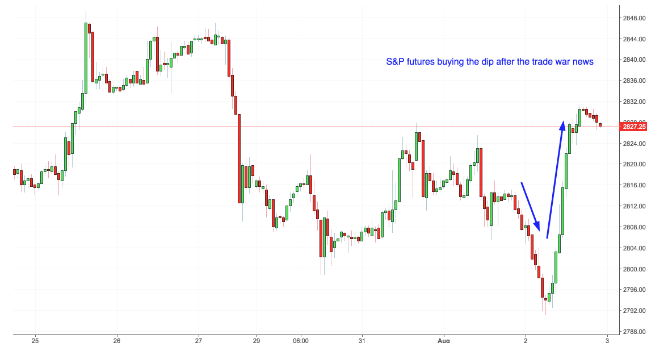
Earnings drive markets over time. Until the global trade issues resolve themselves in negative earnings, investors have been willing to overlook fear in favor of presented earnings growth. We can see the fear surrounding global trade spats dissipate in the market through the VIX yesterday and as the day progressed.
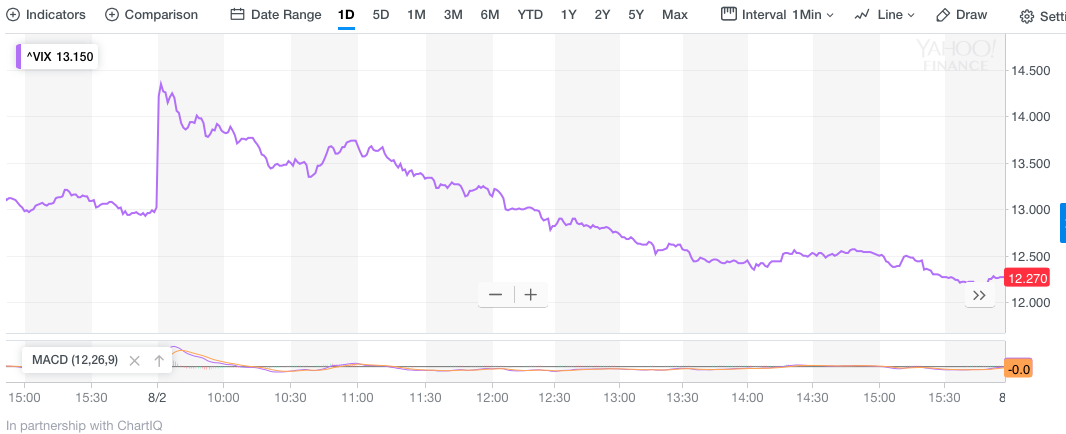
As we can see from the chart of the VIX above, fear rose sharply in the premarket trade on Thursday and declined to its lowest point by the end of the trading day. The volatility of volatility or VVIX index, which had been over 100 last week, and a sign of potential rising volatility to come, has fallen since to roughly 91.50. Additionally, the SKEW index, which had recently risen to nearly 153 last week and signaling more volatile markets ahead, has also fallen to 143 as depicted in the chart below.
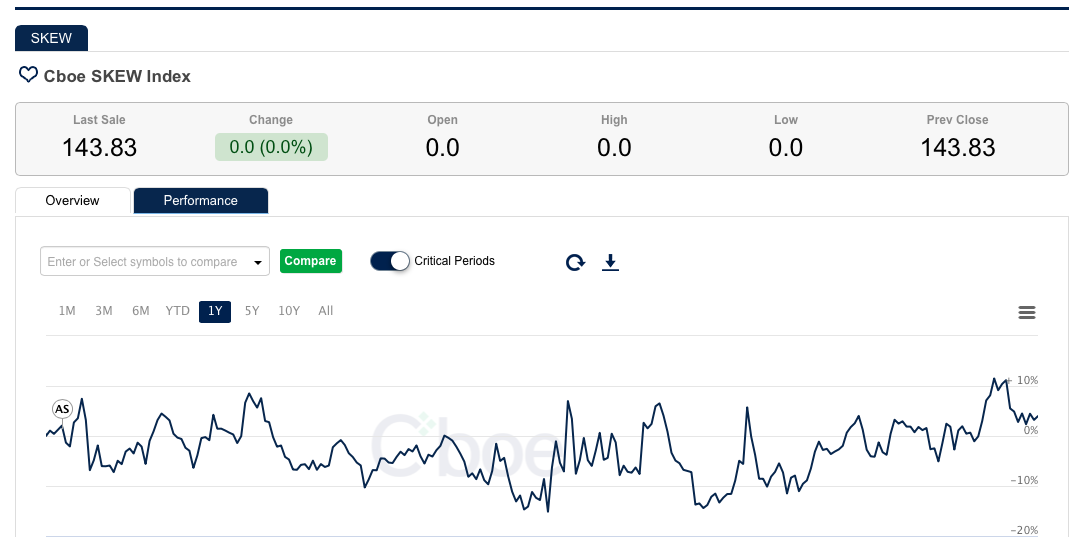
I have been utilizing the Volatility trading vehicles to alert finomgroup.com subscribers (for whom I am employed) of potential trading opportunities throughout 2018. My most recent short-VOL trade for subscribers is depicted below and from Finom Group’s private twitter feed.
![]()
Admittedly, I offer that the short entry price on the trade wasn’t optimal, but nonetheless was profitable and achieved its profit target objective in less than 24 hours. What I want short-VOL traders to better understand from this particular trade is that shorting volatility or inverse VIX-Exchange Traded Products (VIX-ETPs) is not about the initial entry price when shorting. The trade is more properly performed when focused on liquidity levels. Given the nature of volatility, which is completely reactionary and driven by trader/investor psychology, short entry points can often been found wanting for better execution prices. However, given the natural order of markets that correlates to the natural order of volatility, the VIX complex seeks out prolonged periods of complacency post periods of momentary spikes in volatility. As long as a short-VOL trader can maintain liquidity through periods of elevating volatility, their short-VOL positions will eventually be found profitable.
An experienced short-VOL trader will not only position appropriately for rising volatility but take advantage of such periods by increasing their short-VOL positions/exposure. In a recent MarketWatch article, my core VIX trading strategy was outlined. Shawn Langlois, who had covered my perspectives on VOL trading back in 2017, as many of my volatility works were a focus of the larger media, including the New York Times, wrote the article. In Langlois’ article, the reporter offers my core principle activities for shorting VIX-Exchange Traded Products.
- Allocate 20% of investable capital to short VIX-ETPS, namely UVXY, TVIX, and VXX. This is an established core position built over time.
- Maintain a high cash balance which provides roughly 200% liquidity daily
- Trade around my core position daily/weekly, scalping short-VOL opportunities when presented in order to compound annual returns
- Maintain core short-VOL positions until they reach a 90%+ profit profile if the market environment remains optimal to do so
- Participate in a fashion that permits trading my positions during all trading hours available inclusive of pre-market and after-hours trading
- Scale larger core allocation into VIX events of consequence
I will continue to trade what the market delivers, be it in retail stocks or volatility. The month of August is typically a more volatile month for the markets, as the summer doldrums tend to deliver less trading activity and therefore less market liquidity.
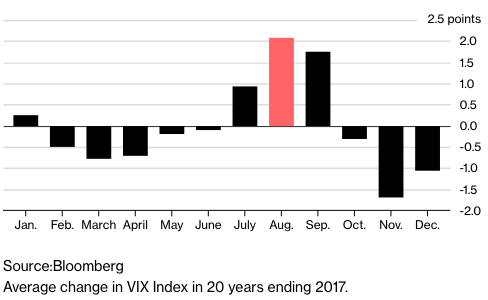
Goldman Sachs Group Inc. has warned that depleted liquidity makes the market prone to crises.
“You have a lot of geopolitical events that could happen this summer,” said Voya’s Reinhard. “August ones are particularly alarming -- that’s when volumes are thin and people are on vacation.”
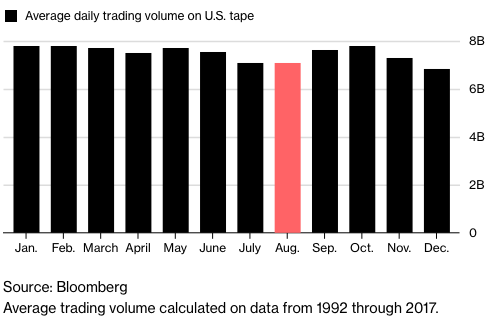
The reality with trading volatility or inverse VIX-ETPs is that these traders will always be faced with headlines and headwinds, warnings if you will. Being short of any trading vehicle has inherent risks. Having said that, those risks are only limited to a traders ability to maintain liquidity through periods where drawdowns are at-hand. Again, what most warnings against the short-VOL crowd fail to acknowledge is that while volatility may rise from time to time, inclusive of August, that period of time is fleeting; short-VOL traders merely need to insure their liquidity through such periods of time.
The short-VOL trade can be a trade of the day or a long-term trading strategy, as it all depends on the individual trader’s risk appetite, resourcefulness and discipline. I have maintained a short-VOL strategy since 2012 and through every major volatility event in the marketplace since. Additionally, I maintain a 15.70 VIX forecast for 2018, +/- .50 bps. Moreover, I encourage short-VOL traders whom are bombarded by warnings on the trading style and verbiage of elevated volatility to recognize the terminology in such warnings offered by large institutions and media types. “Elevated volatility” should be recognized in YOY terms. It should also be recognized as being transitory. Elevated is not the equivalent of perpetually elevating, as this is an impossibility in the equity markets. Investors would not participate in markets that were perpetually found with outsized volatility. The natural order of the market is one in which complacency is found more often expressed than elevating volatility. Every volatility event is found with one constant characteristic or descriptive word: Brevity! It is here today and gone thereafter. Remember the February “Volpocolypse”? It may seem a long time ago, but always an important study for back testing future participations.



